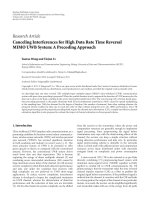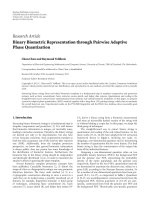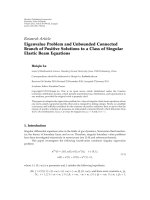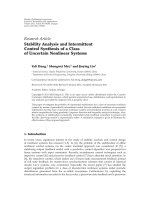Báo cáo hóa học: " Research Article Approximation Methods for Common Fixed Points of Mean Nonexpansive Mapping in Banach Spaces" ppt
Bạn đang xem bản rút gọn của tài liệu. Xem và tải ngay bản đầy đủ của tài liệu tại đây (467.64 KB, 7 trang )
Hindawi Publishing Corporation
Fixed Point Theory and Applications
Volume 2008, Article ID 471532, 7 pages
doi:10.1155/2008/471532
Research Article
Approximation Methods for Common Fixed Points
of Mean Nonexpansive Mapping in Banach Spaces
Zhaohui Gu
1
and Yongjin Li
2
1
Department of Foundation, Guangdong Finance and Economics College, Guangzhou 510420, China
2
Institute of Logic and Cognition, Department of Mathematics, Sun Yat-Sen University,
Guangzhou 510275, China
Correspondence should be addressed to Yongjin Li,
Received 17 October 2007; Accepted 2 January 2008
Recommended by Tomonari Suzuki
Let X be a u niformly convex Banach space, and let S, T be a pair of mean nonexpansive mappings.
In this paper, it is proved that the sequence of Ishikawa iterations associated with S and T converges
to the common fixed point of S and T.
Copyright q 2008 Z. Gu and Y. Li. This is an open access article distributed under the Creative
Commons Attribution License, which permits unrestricted use, distribution, and reproduction in
any medium, provided the original work is properly cited.
1. Introduction and preliminaries
Let X be a Banach space and let S, T be mappings from X to X. The pair of mean nonexpansive
mappings was introduced by Bose in 1:
Sx − Ty≤ax − y b
x − Sx y − Ty
c
x − Ty y − Sx
, 1.1
for all x, y ∈ X, a, b, c ∈ 0, 1, a 2b 2c ≤ 1.
The Ishikawa iteration sequence {x
n
} of S and T was defined by
y
n
1 − β
n
x
n
β
n
Sx
n
,
x
n1
1 − α
n
x
n
α
n
Ty
n
,
1.2
where x
0
∈ X, α
n
,β
n
∈ 0, 1. The recursion formulas 1.2 were first introduced in 1994
by Rashwan and Saddeek 2 in the framework of Hilbert spaces.
In recent years, several authors see 2–6 have studied the convergence of iterations to
a common fixed point for a pair of mappings. Rashwan has studied the convergence of Mann
iterations to a common fixed point see 5 and proved that the Ishikawa iterations converge
2 Fixed Point Theory and Applications
to a unique common fixed point in Hilbert spaces see 2. Recently,
´
Ciri
´
c has proved that if the
sequence of Ishikawa iterations sequence {x
n
} associated with S and T converges to p,thenp
is the common fixed point of S and T see 7.In4, 6, the authors studied the same problem.
In 1, Bose defined the pair of mean nonexpansive mappings, and proved the existence of the
fixed point in Banach spaces. In particular, he proved the following theorem.
Theorem 1.1 see 1. Let X be a uniformly convex Banach space and K a nonempty closed convex
subset of X, S : K→K and T : K→K are a pair of mean nonexpansive mappings, and c
/
0.Then,
i S and T have a common fixed point u;
ii further, if b
/
0,then
a u is the unique common fixed point and unique as a fixed point of each S and T,
b the sequence {x
n
} defined by x
1
Sx
0
,x
2
Tx
1
,x
3
Sx
2
, for any x
0
∈ K, converges
strongly to u.
It is our purpose in this paper to consider an iterative scheme, which converges to a
common fixed point of the pair of mean nonexpansive mappings. Theorem 2.1 extends and
improves the corresponding results in 1.
2. Main results
Now we prove the following theorem which is the main result of this paper.
Theorem 2.1. Let X be a uniformly convex Banach space, S : X→X and T : X→X are a pair of mean
nonexpansive with a nonempty common fixed points set; if b>0, 0 <α≤ α
n
≤ 1/2, 0 ≤ β
n
≤ β<1,
then the Ishikawa sequence {x
n
} converges to the common fixed point of S and T.
Proof. First, we show that the sequence {x
n
} is bounded. For a common fixed point p of S and
T,wehave
Tx − p Tx − Sp
≤ ax − p b
x − Tx p − Sp
c
x − Sp p − Tx
≤ ax − p b
x − p p − Tx
c
x − Sp p − Tx
.
2.1
Let L a
b c/1 − b − c,bya 2b 2c ≤ 1, it is easy to see that a b c ≤ 1 − b − c,thus
0 ≤ L ≤ 1andTx− p≤Lx − p≤x − p.
Similarly, we have Sx − p≤Lx − p≤x − p,
x
n1
− p
1 − α
n
x
n
α
n
Ty
n
− p
1 − α
n
x
n
− p
α
n
Ty
n
− p
≤
1 − α
n
x
n
− p
α
n
Ty
n
− p
≤
1 − α
n
x
n
− p
α
n
L
y
n
− p
≤
1 − α
n
x
n
− p
α
n
1 − β
n
x
n
β
n
Sx
n
− p
1 − α
n
x
n
− p
α
n
1 − β
n
x
n
− p
β
n
Sx
n
− p
≤
1 − α
n
x
n
− p
α
n
1 − β
n
x
n
− p
α
n
β
n
Sx
n
− p
≤
1 − α
n
x
n
− p
α
n
1 − β
n
x
n
− p
α
n
β
n
x
n
− p
1 − α
n
α
n
1 − β
n
α
n
β
n
x
n
− p
x
n
− p
.
2.2
Z. Gu and Y. Li 3
So
x
n1
− p
≤
x
n
− p
≤
x
n−1
− p
≤ ··· ≤
x
0
− p
.
2.3
Hence, {x
n
} is bounded.
Second, we show that
lim
n→∞
x
n
− Ty
n
0. 2.4
We recall that Banach space X is called uniformly convex if δε > 0 for every ε>0, where the
modulus δε of convexity of X is defined by
δεinf
1 −
x y
2
: x≤1, y≤1, x − y≥ε
, 2.5
for every ε with 0 ≤ ε ≤ 2. It is easy to see that Banach space X is uniformly convex if and only
if for any x
n
,y
n
∈ B
X
{x |x≤1}, x
n
y
n
→2 implies x
n
− y
n
→0.
Assume that lim
n→∞
x
n
− Ty
n
/
0, then there exist a subsequence {x
n
k
} of {x
n
} and a
real number ε
0
> 0, such that
x
n
k
− Ty
n
k
≥ ε
0
,k 1, 2, 3, 2.6
On the other hand, for a common fixed point p of T and S,wehave
x
n
k
− Ty
n
k
≤
x
n
k
− p
Ty
n
k
− p
≤
x
n
k
− p
L
y
n
k
− p
x
n
k
− p
L
1 − β
n
k
x
n
k
β
n
k
Sx
n
k
− p
x
n
k
− p
L
1 − β
n
k
x
n
k
− p
β
n
k
Sx
n
k
− p
≤
x
n
k
− p
1 − β
n
k
L
x
n
k
− p
β
n
k
L
Sx
n
k
− p
≤
1
1 − β
n
k
L β
n
k
L
2
x
n
k
− p
≤ 1 L
x
n
k
− p
≤ 2
x
n
k
− p
.
2.7
Thus,
x
n
k
− p
≥
1
2
x
n
k
− Ty
n
k
≥
ε
0
2
ε
1
> 0. 2.8
Because
Ty
n
− p
≤
y
n
− p
≤
1 − β
n
x
n
β
n
Sx
n
− p
1 − β
n
x
n
− p
β
n
Sx
n
− p
≤
1 − β
n
x
n
− p
β
n
Sx
n
− p
≤
1 − β
n
x
n
− p
β
n
x
n
− p
≤
x
n
− p
,
2.9
we know {x
n
} is bounded, then there exists M>0, such that x
n
− p≤M. Thus, Ty
n
− p≤
x
n
− p≤M.
4 Fixed Point Theory and Applications
Furthermore, we have
x
n
k
− p
x
n
k
− p
−
Ty
n
k
− p
x
n
k
− p
x
n
k
− Ty
n
k
x
n
k
− p
≥
ε
1
M
> 0. 2.10
From
x
n
k
− p
x
n
k
− p
1,
Ty
n
k
− p
x
n
k
− p
≤ L ≤ 1, 2.11
and the fact that X is uniformly convex Banach space, there exists δ>0, such that
x
n
k
− p
x
n
k
− p
Ty
n
k
− p
x
n
k
− p
≤ 2 − δ. 2.12
Thus,
x
n
k
1
− p
1 − α
n
k
x
n
k
α
n
k
Ty
n
k
− p
≤
1 − 2α
n
k
x
n
k
− p
α
n
k
x
n
k
− p
α
n
k
Ty
n
k
− p
≤
1 − 2α
n
k
x
n
k
− p
α
n
k
x
n
k
− p
·
x
n
k
− p
x
n
k
− p
Ty
n
k
− p
x
n
k
− p
≤
1 − 2α
n
k
x
n
k
− p
2 − δα
n
k
x
n
k
− p
≤
1 − δα
n
k
x
n
k
− p
x
n
k
− p
− δα
n
k
x
n
k
− p
≤
x
n
k
− p
− δαε
1
.
2.13
Using 2.3,weobtainthat
x
n
k
1
− p
≤
x
n
k
− p
− δαε
1
≤
x
n
k
−1
− p
− δαε
1
≤
x
n
k
−2
− p
− δαε
1
≤ ··· ≤
x
n
k−1
1
− p
− δαε
1
≤
x
n
k−1
− p
− 2δαε
1
.
2.14
So
x
n
k
− p
≤
x
n
k−1
− p
− δαε
1
≤
x
n
k−2
− p
− 2δαε
1
≤ ··· ≤
x
n
1
− p
− k − 1δαε
1
. 2.15
Let k→∞,thenwehavex
n
k
− p < 0. It is a contradiction. Hence, lim
n→∞
x
n
− Ty
n
0.
Third, we show that
lim
n→∞
x
n
− Sx
n
0. 2.16
Since
x
n
− Sx
n
≤
x
n
− Ty
n
Ty
n
− Sx
n
≤
x
n
− Ty
n
a
x
n
− y
n
b
x
n
− Sx
n
y
n
− Ty
n
c
x
n
− Ty
n
y
n
− Sx
n
1 c
x
n
− Ty
n
a
x
n
− y
n
b
x
n
− Sx
n
b
y
n
− Ty
n
c
y
n
− Sx
n
1 c
x
n
− Ty
n
a
1 − β
n
x
n
β
n
Sx
n
− x
n
b
x
n
− Sx
n
b
1 − β
n
x
n
β
n
Sx
n
− Ty
n
c
1 − β
n
x
n
β
n
Sx
n
− Sx
n
≤ 1 c
x
n
− Ty
n
aβ
n
x
n
− Sx
n
b
x
n
− Sx
n
bβ
n
x
n
− Sx
n
b
x
n
− Ty
n
c
1 − β
n
x
n
− Sx
n
1 b c
x
n
− Ty
n
aβ
n
b bβ
n
c
1 − β
n
x
n
− Sx
n
,
2.17
Z. Gu and Y. Li 5
we have
1 − aβ
n
− b − bβ
n
− c
1 − β
n
x
n
− Sx
n
≤ 1 b c
x
n
− Ty
n
.
2.18
Let M
1
1 − aβ
n
− b − bβ
n
− c1 − β
n
,then
M
1
1 − aβ
n
− b − bβ
n
− c cβ
n
1 − b − c − a b − cβ
n
≥ a b c − a b − cβ
n
a b
1 − β
n
c
1 β
n
≥ a b1 − βc>0.
2.19
So
x
n
− Sx
n
≤
1 b c
M
1
x
n
− Ty
n
.
2.20
Using 2.4,wegetthat
lim
n→∞
x
n
− Sx
n
0.
2.21
Forth, we show that if the Ishikawa sequence {x
n
} converges to some point p ∈ X,then
p is the common fixed point of S and T.By
y
n
1 − β
n
x
n
β
n
Sx
n
,
x
n1
1 − α
n
x
n
α
n
Ty
n
,
2.22
we have x
n
− Ty
n
1/α
n
x
n1
− x
n
. Since {x
n
} is a convergent sequence, we get lim
n→∞
x
n
−
Ty
n
0. It is easy to see that x
n
− y
n
β
n
x
n
− Sx
n
and Sx
n
− y
n
1 − β
n
x
n
− Sx
n
.
On the other hand,
y
n
− Ty
n
1 − β
n
x
n
β
n
Sx
n
− Ty
n
≤
1 − β
n
x
n
− Ty
n
β
n
Sx
n
− Ty
n
. 2.23
By 1.1,weobtain
Ty
n
− Sx
n
≤ a
x
n
− y
n
b
x
n
− Sx
n
y
n
− Ty
n
c
x
n
− Ty
n
y
n
− Sx
n
≤ aβ
n
x
n
− Sx
n
b
x
n
− Sx
n
b
1 − β
n
x
n
− Ty
n
bβ
n
Sx
n
− Ty
n
c
x
n
− Ty
n
c
1 − β
n
x
n
− Sx
n
aβ
n
b c
1 − β
n
x
n
− Sx
n
b
1 − β
n
c
x
n
− Ty
n
bβ
n
Sx
n
− Ty
n
.
2.24
Since
x
n
− Sx
n
≤
Sx
n
− Ty
n
x
n
− Ty
n
,
2.25
we get
Ty
n
− Sx
n
≤
b
1 − β
n
c aβ
n
b c
1 − β
n
x
n
− Ty
n
bβ
n
aβ
n
b c
1 − β
n
Sx
n
− Ty
n
.
2.26
6 Fixed Point Theory and Applications
So
1 − b − c − a b − cβ
n
Ty
n
− Sx
n
≤
b
1 − β
n
c aβ
n
b c
1 − β
n
x
n
− Ty
n
.
2.27
Let M
2
1 − b − c − a b − cβ
n
, Since 0 ≤ β
n
≤ β<1, we have
M
2
≥ a b c − a b − cβ
n
≥ a b
1 − β
n
c
1 β
n
≥ a b1 − βc>0. 2.28
It is easy to see that
b
1 − β
n
c aβ
n
b c
1 − β
n
> 0.
2.29
Note that lim
n→∞
x
n
− Ty
n
0, then we get
lim
n→∞
Sx
n
− Ty
n
0, lim
n→∞
y
n
− Ty
n
0.
2.30
So lim
n→∞
x
n
− y
n
lim
n→∞
β
n
Sx
n
− x
n
0.
Let p lim
n→∞
x
n
, then lim
n→∞
y
n
p, lim
n→∞
Sx
n
p, lim
n→∞
Ty
n
p.By1.1,we
have
Sx
n
− Tp
≤ a
x
n
− p
b
x
n
− Sx
n
p − Tp
c
x
n
− Tp
p − Sx
n
. 2.31
Let n→∞,thenweget
p − Tp≤b cp − Tp.
2.32
Since b c<1, it follows that
p − Tp 0, that is Tp p. 2.33
Similarly, we can prove that Sp p.Sop is the common fixed point of S and T.
Finally, we show that {Sx
n
} is a Cauchy sequence. For any m, n ∈ N,
Sx
n
− Sx
nm
≤
Sx
n
− Ty
nm
Sx
nm
− Ty
nm
≤ a
x
n
− y
nm
b
x
n
− Sx
n
y
nm
− Ty
nm
c
x
n
− Ty
nm
y
nm
− Sx
n
Sx
nm
− Ty
nm
≤ a
x
n
− Sx
n
Sx
n
− Sx
nm
Sx
nm
− y
nm
b
x
n
− Sx
n
y
nm
− Ty
nm
c
x
n
− Sx
n
Sx
n
− Sx
nm
Sx
nm
− Ty
nm
y
nm
− Sx
nm
Sx
nm
− Sx
n
Sx
nm
− Ty
nm
.
2.34
Since b>0, thus we get 1 − a − 2c>0. Simplify, then we have
Sx
n
− Sx
nm
≤ A
x
n
− Sx
n
B
y
nm
− Ty
nm
C
y
nm
− Sx
nm
D
Sx
nm
− Ty
nm
,
2.35
where A a b c/1 − a − 2c ≥ 0,B b/1 − a − 2c ≥ 0,Ca c/1 − a − 2c ≥ 0, and
D 1 c/1 − a − 2c ≥ 0. By 2.16 and 2.30, we know that
x
n
− Sx
n
−→ 0,
y
nm
− Ty
nm
−→ 0,
Sx
nm
− Ty
nm
−→ 0.
2.36
Z. Gu and Y. Li 7
So it is easy to see that y
nm
− Sx
nm
→0. Thus, Sx
n
− Sx
nm
→0, that is {Sx
n
} is a Cauchy
sequence. Hence, there exists p, such that p lim
n→∞
Sx
n
. We know that p lim
n→∞
x
n
and p
is the common fixed point of S and T. This completes the proof of the theorem.
Acknowledgment
The work was partially supported by the Emphases Natural Science Foundation of Guangdong
Institution of Higher Learning, College and University no. 05Z026.
References
1 S. C. Bose, “Common fixed points of mappings in a uniformly convex Banach space,” Journal of the
London Mathematical Society, vol. 18, no. 1, pp. 151–156, 1978.
2 R. A. Rashwan and A. M. Saddeek, “On the Ishikawa iteration process in Hilbert spaces,” Collectanea
Mathematica, vol. 45, no. 1, pp. 45–52, 1994.
3 V. Berinde, “On the convergence of the Ishikawa iteration in the class of quasi contractive operators,”
Acta Mathematica Universitatis Comenianae, vol. 73, no. 1, pp. 119–126, 2004.
4 P E. Maing
´
e, “Approximation methods for common fixed points of nonexpansive mappings in Hilbert
spaces,” Journal of Mathematical Analysis and Applications, vol. 325, no. 1, pp. 469–479, 2007.
5 R. A. Rashwan, “On the convergence of Mann iterates to a common fixed point for a pair of mappings,”
Demonstratio Mathematica, vol. 23, no. 3, pp. 709–712, 1990.
6 Y. Song and R. Chen, “Iterative approximation to common fixed points of nonexpansive mapping se-
quences in reflexive Banach spaces,” Nonlinear Analysis: Theory, Methods & Applications,vol.66,no.3,
pp. 591–603, 2007.
7 Lj. B.
´
Ciri
´
c, J. S. Ume, and M. S. Khan, “On the convergence of the Ishikawa iterates to a common fixed
point of two mappings,” Archivum Mathematicum, vol. 39, no. 2, pp. 123–127, 2003.









